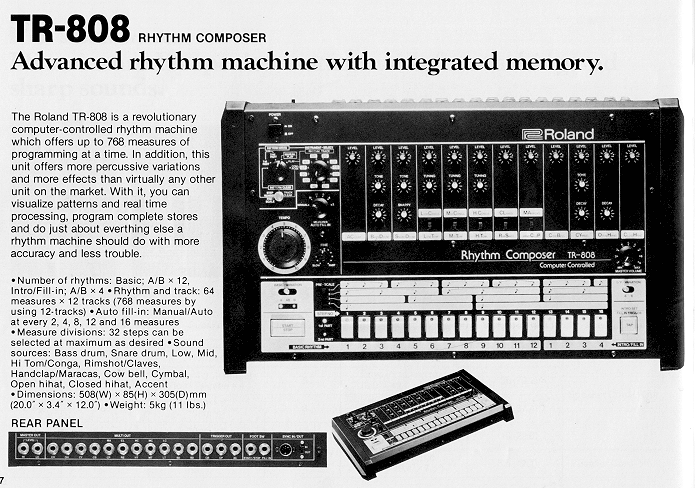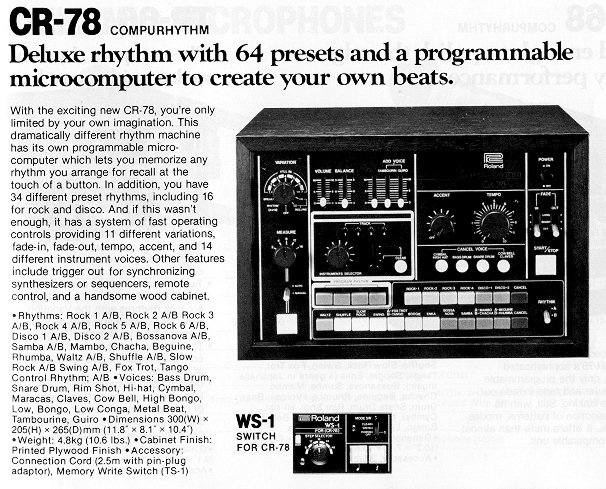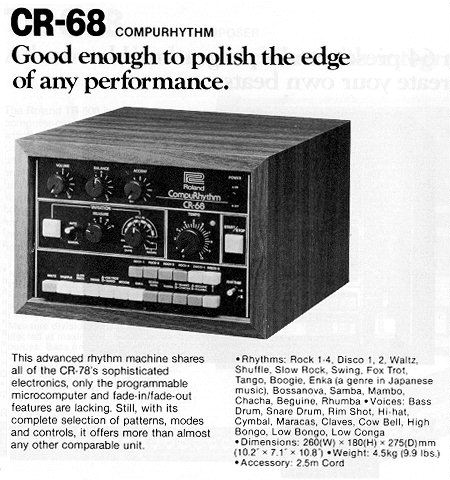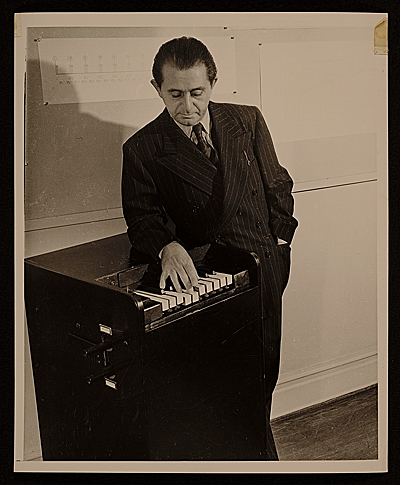Some information from a website I found:
http://microchipseries.com/?p=42
The website has an article detailing the history of the Roland tr-808, 'one of the first programmable drum machines'.
Introduced in the early ’80s as one of the first programmable drum machines, the tr-808 was surpassed long ago by more high-tech musical tools. And yet musicians of all stripes and styles have deemed it indispensable for its stark percussion sound. With its metronomic precision, it may have none of the swing of a human drummer, but the 808 can still provide a futuristic kind of funkiness, especially when it’s in the right hands. This special timeline reveals how this once-lowly machine attained its iconic status.
1980: The Roland Corporation introduces the Roland TR-808, a programmable drum machine. According to Greg Rule’s book
Future Shock, five percussion sounds characterize the 808: “the hum kick, the ticky snare, the tishy hi-hats (open and closed) and the spacey cowbell.” A Roland representative later credits the machine’s design to a Mr. Nakamura (responsible for the analog voice circuits) and a Mr. Matsuoka (who developed the software).
A 1980s advertisement for the 808. (Roland/Drum Machine Museum)
The 808 receives many poor reviews in the gearhead press of the day, generally being deemed inferior to the Linn LM-1, the first drum machine to use digital samples (i.e., prerecorded rather than machine-generated sounds). Nevertheless, it gains some popularity due to its relatively low cost of $1,195 US.
Yellow Magic Orchestra, the pioneering Japanese synth-pop band, is the first band to put the 808 to use.
1982: Soul icon Marvin Gaye is the first artist to score a major hit with an 808-propelled song, when
Sexual Healing becomes a worldwide smash. Even so, the obviously synthetic sound of the rhythm patterns does not gain wide popularity. Instead, the 808 becomes a cornerstone of the emerging genres of electronic music and hip hop, with the release of
Planet Rock by Afrika Bambaataa and the Soulsonic Force. Marking, in the words of producer Arthur Baker, a “marriage of electronic music with street culture and black music,” this thunderous single would also have a massive influence on subgenres like Miami bass and Detroit techno, thereby cementing the 808’s reputation as a fundamental element of futuristic sounds.
1983: Roland ceases production of the model — according to
Future Shock, approximately 12,000 had been made. The same year, British band New Order makes a transatlantic pilgrimage to New York to work with producer Arthur Baker; their first collaboration is the 808-laden single
Confusion.
1983: Cybotron (an early
electro group formed in 1980 by
Juan Atkins and
Richard “3070″ Davis) release “Clear”, an electro-laden odyssey track, that combines the sound of earlier pioneers
Kraftwerk, the funk sound of
George Clinton, and the rock sound of the time, to create a new sound that would establish “electro” as a genre. The 808 is heavily used as source of rhythm for much of these songs, including “Clear”.
1985: MC ADE releases “
Bass Rock Express“ and is often credited as being the first Miami bass record, establishing a sound for a new genre. Known for its boomy kick drums, lo-fi hand claps in place of snares, and accents of the 808 attempt at a cowbell.
1986: The 2 Live Crew release,
The 2 Live Crew Is What We Are, controversial for its sexually explicit lyrics, launches Miami Bass into the public eye. Known for its sustained kick drums, it ushers in the car audio craze. 1989′s
As Nasty As They Wanna Be, further launched Miami Bass and the 808 sound into mainstream media.
1988: 808 State forms in New Order’s hometown of Manchester. The band soon becomes a progenitor of acid house, a British take on the stark, heavy electronic rhythms then emerging from Detroit and Chicago. In the U.S., techno will remain an underground sound. But in the U.K., rave music and culture goes mainstream, with acts like 808 State topping the charts, thereby making the 808 sound a staple on radio. Graham Massey of 808 State later admits that the group members didn’t think much of the Roland TR-808 initially, but the abundance of the machines in secondhand stores made them affordable and therefore popular with techno producers. The artificiality of the 808 sound is dearly appreciated by this new generation of futurists.
1993: Richie Hawtin — a DJ and musician from Windsor, Ont. — releases his first music under the
Plastikman moniker, and ensures that the 808 sound is a key component in the decade’s most austere and minimalist varieties of electronic music. Hawtin later contributes a short track named
808 Loop on his 2001 mix disc
DE9: Closer to the Edit.
1994: The 808 sound hits saturation levels on alternative-rock radio stations in North America when Nine Inch Nails main man Trent Reznor exploits its potential for doomy menace on the industrial-strength hit
Closer.
1996: ReBirth RB-338 (commonly referred to as simply ReBirth) was arguably the first
software synthesizer .
Propellerhead Software, had constructed this application to emulate a tr808, a tr909, and not one but two tb303. This launched software synthesizers and a whole slew of “clone” software that made the recognizable sound available to those that could not afford the now legendary used market prices ($2000-$3000 US dollars) of the original hardware.
1998: “Nothing sounds quite like an 8-0-8!” So goes the rallying cry in
Super Disco Breakin’, a song on the Beastie Boys’ album
Hello Nasty. The list of artists similarly inspired to give shoutouts to Roland’s gift is many. These resounding voices and praises for this loved sound only ensure that it will continue to be staple bit of kit, in many studios for years to come.





















